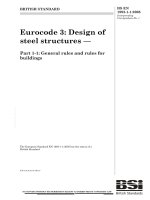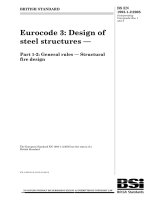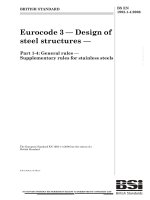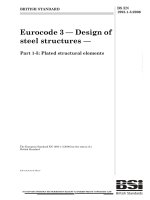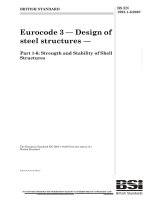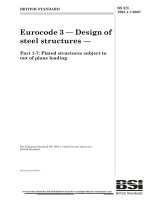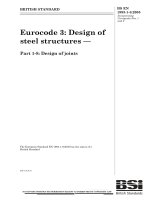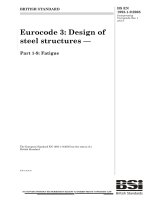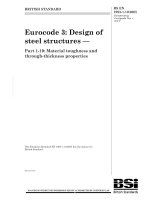Tiêu chuẩn Châu Âu EC3: Kết cấu thép phần 4.3: Ống dẫn (Eurocode3 BS EN1993 4 3 e 2007 Design of steel structures part 4.3: Pipeline)
Bạn đang xem bản rút gọn của tài liệu. Xem và tải ngay bản đầy đủ của tài liệu tại đây (459.23 KB, 44 trang )
BRITISH STANDARD
BS EN
1993-4-3:2007
Eurocode 3 — Design of
steel structures —
--`,,`,`,``,,,,`,`,```,```,```-`-`,,`,,`,`,,`---
Part 4-3: Pipelines
The European Standard EN 1993-4-3:2007 has the status of a
British Standard
ICS 23.040.01; 91.010.30; 91.080.10
12 &23<,1* :,7+287 %6, 3(50,66,21 (;&(37 $6 3(50,77(' %< &23<5,*+7 /$:
BS EN 1993-4-3:2007
National foreword
This British Standard was published by BSI. It is the UK implementation of
EN 1993-4-3:2007.
The UK participation in its preparation was entrusted by Technical Committee
B/525, Building and civil engineering structures, to Subcommittee B/525/31,
Structural use of steel.
A list of organizations represented on this committee can be obtained on
request to its secretary.
This publication does not purport to include all the necessary provisions of a
contract. Users are responsible for its correct application.
Compliance with a British Standard cannot confer immunity from
legal obligations.
This British Standard was
published under the authority
of the Standards Policy and
Strategy Committee
on 31 May 2007
Amendments issued since publication
Amd. No.
Date
© BSI 2007
ISBN 978 0 580 50671 0
--`,,`,`,``,,,,`,`,```,```,```-`-`,,`,,`,`,,`---
Comments
EUROPEAN STANDARD
EN 1993-4-3
NORME EUROPÉENNE
EUROPÄISCHE NORM
February 2007
ICS 23.040.01; 91.010.30; 91.080.10
Supersedes ENV 1993-4-3:1999
English Version
Eurocode 3 - Design of steel structures - Part 4-3: Pipelines
Eurocode 3 - Calcul des constructions en acier - Partie 4-3:
Tuyauterie
Eurocode 3 - Bemessung und Konstruktion von
Stahlbauten - Teil 4-3: Rohrleitungen
This European Standard was approved by CEN on 12 June 2006.
CEN members are bound to comply with the CEN/CENELEC Internal Regulations which stipulate the conditions for giving this European
Standard the status of a national standard without any alteration. Up-to-date lists and bibliographical references concerning such national
standards may be obtained on application to the CEN Management Centre or to any CEN member.
This European Standard exists in three official versions (English, French, German). A version in any other language made by translation
under the responsibility of a CEN member into its own language and notified to the CEN Management Centre has the same status as the
official versions.
CEN members are the national standards bodies of Austria, Belgium, Bulgaria, Cyprus, Czech Republic, Denmark, Estonia, Finland,
France, Germany, Greece, Hungary, Iceland, Ireland, Italy, Latvia, Lithuania, Luxembourg, Malta, Netherlands, Norway, Poland, Portugal,
Romania, Slovakia, Slovenia, Spain, Sweden, Switzerland and United Kingdom.
EUROPEAN COMMITTEE FOR STANDARDIZATION
COMITÉ EUROPÉEN DE NORMALISATION
EUROPÄISCHES KOMITEE FÜR NORMUNG
Management Centre: rue de Stassart, 36
© 2007 CEN
B-1050 Brussels
All rights of exploitation in any form and by any means reserved
worldwide for CEN national Members.
--`,,`,`,``,,,,`,`,```,```,```-`-`,,`,,`,`,,`---
Ref. No. EN 1993-4-3:2007: E
EN 1993-4-3: 2007 (E)
Content
Foreword
Background of the Eurocode programme
Status and field of application of Eurocodes
National Standards implementing Eurocodes
Links between Eurocodes and harmonised technical specifications (ENs and ETAs)
Additional information specific to EN 1993-4-3
National Annex for EN 1993-4-3
1 General
1.1
1.2
1.3
1.4
1.5
1.6
1.7
1.8
Scope
Normative references
Assumptions
Distinction between principles and application rules
Definitions
S.I. units
Symbols used in Part 4-3 of Eurocode 3
Terminology
3
3
4
4
5
5
5
7
7
8
9
9
9
10
10
11
--`,,`,`,``,,,,`,`,```,```,```-`-`,,`,,`,`,,`---
2 Basis of design
2.1 General
2.2 Fundamental requirements for pipelines
2.3 Reliability differentiation
2.4 Methods of analysis
2.5 Ultimate limit states
2.6 Serviceability limit states
13
13
13
13
14
14
15
3 Properties of materials
3.1 General
3.2 Mechanical properties of pipeline steels
3.3 Mechanical properties of welds
3.4 Toughness requirements of plate materials and welds
3.5 Fasteners
3.6 Soil properties
16
16
16
16
17
17
17
4 Actions
4.1
4.2
4.3
4.4
18
18
18
18
19
Actions to be considered
Partial factors for actions
Load combinations for ultimate limit states
Load combinations for serviceability limit state design
5 Analysis
5.1 Structural models
5.2 Ultimate limit state verification
5.3 Serviceability limit state verifications
20
20
23
25
6 Structural design aspects of fabrication and erection
25
Annex A: [informative] - Analysis of resistances, deformations, stresses and strains of buried
pipelines
A.1 Procedure and scope of analysis
A.2 Analysis for straight pipes
A.3 Analysis for bends
26
26
26
33
Annex B: [informative] - Bibliography to National Standards and design guides
34
Annex C: [informative] - Bibliography
C.1 General bibliography on pipelines
C.2 Bibliography on geotechnical engineering
35
35
39
2
EN 1993-4-3: 2007 (E)
Foreword
--`,,`,`,``,,,,`,`,```,```,```-`-`,,`,,`,`,,`---
This European Standard EN 1993-4-3, “Eurocode 3: Design of steel structures – Part 4.3: Pipelines”, has
been prepared by Technical Committee CEN/TC250 « Structural Eurocodes », the Secretariat of which is
held by BSI. CEN/TC250 is responsible for all Structural Eurocodes.
This European Standard shall be given the status of a National Standard, either by publication of an
identical text or by endorsement, at the latest by August 2007, and conflicting National Standards shall be
withdrawn at latest by March 2010.
This document supersedes ENV 1993-4-3:1999.
According to the CEN-CENELEC Internal Regulations, the National Standard Organizations of the
following countries are bound to implement this European Standard: Austria, Belgium, Bulgaria, Cyprus, Czech
Republic, Denmark, Estonia, Finland, France, Germany, Greece, Hungary, Iceland, Ireland, Italy,
Latvia, Lithuania, Luxembourg, Malta, Netherlands, Norway, Poland, Portugal, Romania, Slovakia,
Slovenia, Spain, Sweden, Switzerland and United Kingdom.
Background of the Eurocode programme
In 1975, the Commission of the European Community decided on an action programme in the field of
construction, based on article 95 of the Treaty. The objective of the programme was the elimination of
technical obstacles to trade and the harmonisation of technical specifications.
Within this action programme, the Commission took the initiative to establish a set of harmonised
technical rules for the design of construction works which, in a first stage, would serve as an alternative
to the National rules in force in the Member States and, ultimately, would replace them.
For fifteen years, the Commission, with the help of a Steering Committee with Representatives of
Member States, conducted the development of the Eurocodes programme, which led to the first
generation of European codes in the 1980’s.
In 1989, the Commission and the Member States of the EU and EFTA decided, on the basis of an
agreement1) between the Commission and CEN, to transfer the preparation and the publication of the
Eurocodes to the CEN through a series of Mandates, in order to provide them with a future status of
European Standard (EN). This links de facto the Eurocodes with the provisions of all the Council’s
Directives and/or Commission’s Decisions dealing with European standards (e.g. the Council Directive
89/106/EEC on construction products - CPD - and Council Directives 93/37/EEC, 92/50/EEC and
89/440/EEC on public works and services and equivalent EFTA Directives initiated in pursuit of setting
up the internal market).
The Structural Eurocode programme comprises the following standards generally consisting of a
number of Parts:
EN1990
EN1991
EN1992
EN1993
EN1994
Eurocode 0: Basis of structural design
Eurocode 1: Actions on structures
Eurocode 2: Design of concrete structures
Eurocode 3: Design of steel structures
Eurocode 4: Design of composite steel and concrete structures
1)
Agreement between the Commission of the European Communities and the European Committee for Standardisation (CEN)
concerning the work on EUROCODES for the design of building and civil engineering works (BC/CEN/03/89).
3
EN 1993-4-3: 2007 (E)
EN1995
EN1996
EN1997
EN1998
EN1999
Eurocode 5: Design of timber structures
Eurocode 6: Design of masonry structures
Eurocode 7: Geotechnical design
Eurocode 8: Design of structures for earthquake resistance
Eurocode 9: Design of aluminium structures
Eurocode standards recognise the responsibility of regulatory authorities in each Member State and
have safeguarded their right to determine values related to regulatory safety matters at national level
where these continue to vary from State to State.
Status and field of application of Eurocodes
The Member States of the EU and EFTA recognise that EUROCODES serve as reference documents
for the following purposes:
-
as a means to prove compliance of building and civil engineering works with the essential
requirements of Council Directive 89/106/EEC, particularly Essential Requirement N°1 Mechanical resistance and stability - and Essential Requirement N°2 - Safety in case of fire;
as a basis for specifying contracts for construction works and related engineering services;
as a framework for drawing up harmonised technical specifications for construction products (ENs
and ETAs)
The Eurocodes, as far as they concern the construction works themselves, have a direct relationship
with the Interpretative Documents2) referred to in Article 12 of the CPD, although they are of a
different nature from harmonised product standards3). Therefore, technical aspects arising from the
Eurocodes work need to be adequately considered by CEN Technical Committees and/or EOTA
Working Groups working on product standards with a view to achieving full compatibility of these
technical specifications with the Eurocodes.
The Eurocode standards provide common structural design rules for everyday use for the design of
whole structures and component products of both a traditional and an innovative nature. Unusual forms
of construction or design conditions are not specifically covered and additional expert consideration
will be required by the designer in such cases.
National Standards implementing Eurocodes
The National Standards implementing Eurocodes will comprise the full text of the Eurocode (including
any annexes), as published by CEN, which may be preceded by a National title page and National
foreword, and may be followed by a National Annex.
The National Annex may only contain information on those parameters which are left open in the
Eurocode for national choice, known as Nationally Determined Parameters, to be used for the design of
buildings and civil engineering works to be constructed in the country concerned, i.e. :
2)
According to Art. 3.3 of the CPD, the essential requirements (ERs) shall be given concrete form in interpretative
documents for the creation of the necessary links between the essential requirements and the mandates for harmonised ENs and
ETAGs/ETAs.
3)
According to Art. 12 of the CPD the interpretative documents shall :
(a)
give concrete form to the essential requirements by harmonising the terminology and the technical bases and
indicating classes or levels for each requirement where necessary ;
(b)
indicate methods of correlating these classes or levels of requirement with the technical specifications, e.g.
methods of calculation and of proof, technical rules for project design, etc. ;
(c)
serve as a reference for the establishment of harmonised standards and guidelines for European technical
approvals.
The Eurocodes, de facto, play a similar role in the field of the ER 1 and a part of ER 2.
4
--`,,`,`,``,,,,`,`,```,```,```-`-`,,`,,`,`,,`---
EN 1993-4-3: 2007 (E)
-
values and/or classes where alternatives are given in the Eurocode,
values to be used where a symbol only is given in the Eurocode,
country specific data (geographical, climatic, etc), e.g. snow map,
the procedure to be used where alternative procedures are given in the Eurocode,
decisions on the application of informative annexes,
references to non-contradictory complementary information to assist the user to apply the
Eurocode.
Links between Eurocodes and harmonised technical specifications (ENs and ETAs)
There is a need for consistency between the harmonised technical specifications for construction
products and the technical rules for works4). Furthermore, all the information accompanying the CE
Marking of the construction products which refer to Eurocodes shall clearly mention which Nationally
Determined Parameters have been taken into account.
Additional information specific to EN 1993-4-3
EN 1993-4-3 gives design rules for the structural design of buried pipelines, in particular for the
evaluation of the strength, stiffness and deformation capacity.
It is recognized that many standards exist for the design of pipelines covering many different aspects.
Examples are routing, pressure safety systems, corrosion protection, construction and welding,
operation and maintenance. For aspects other than the structural design of the pipeline itself, reference
is made to the relevant European standards listed in 1.3. This is also the case for elements like valves,
fittings, insulating couplings, tees and caps.
Because up till now in EN 1991, no rules exist for actions (loads) on pipelines, reference is made to
relevant EN standards on pipelines e.g. EN 1594 on gas transmission pipelines and EN 14161 on
pipeline transportation systems for the petroleum and natural gas industries.
National Annex for EN 1993-4-3
This standard gives alternative procedures, values and recommendations for classes with notes
indicating where national choices may have to be made. Therefore the National Standard implementing
EN 1993-4-3 should have a National Annex containing all Nationally Determined Parameters to be
used for the design of buildings and civil engineering works to be constructed in the relevant country.
National choice is allowed in EN 1993-4-3 through paragraphs:
2.3 (2)
3.2 (2)P, (3), (4)
3.3 (2), (3), (4)
3.4 (3)
4.2 (1)P
4)
see Art.3.3 and Art.12 of the CPD, as well as clauses 4.2, 4.3.1, 4.3.2 and 5.2 of ID 1.
5
--`,,`,`,``,,,,`,`,```,```,```-`-`,,`,,`,`,,`---
The rules for local buckling in this part EN 1993-4-3 are in line with those in other pipeline standards.
The design critical curvatures according to EN 1993-4-3 are larger than those that could be deduced
from EN 1993-1-6. The main reasons are that the loading in buried pipelines is mainly deformation
controlled and the consequences of local buckling are less severe than in structures where the loading is
mainly load controlled.
EN 1993-4-3: 2007 (E)
--`,,`,`,``,,,,`,`,```,```,```-`-`,,`,,`,`,,`---
5.1.1 (2), (3), (4), (5), (6), (9), (10), (11), (12), (13)
5.2.3 (2)
5.2.4 (1)
6
EN 1993-4-3: 2007 (E)
1
General
1.1
Scope
(1) This Part 4-3 of EN 1993 provides principles and application rules for the structural design of
cylindrical steel pipelines for the transport of liquids or gases or mixtures of liquids and gases at
ambient temperatures, which are not treated by other European standards covering particular
applications.
(2)
Standards dealing with specific pipeline applications should be used for these purposes, notably
-
EN 805 : 2000 for water supply systems (drinking water);
EN 1295: 1997 for buried pipelines under various conditions of loading (waste water);
EN 1594: 2000 for gas supply systems for operating pressures over 16 bar;
EN 12007: 2000 for gas supply systems up to and including 16 bar;
EN 12732: 2000 for welding;
EN 13941: 2003 for pre-insulated bonded pipe systems for district heating;
EN 13480: 2002 for industrial pipelines;
EN 14161: 2004 for pipeline transportation systems for the petroleum and natural gas industries.
Rules related to special requirements of seismic design are provided in EN 1998-4 (Eurocode 8:
Part 4 "Design of structures for earthquake resistance: Silos, tanks and pipelines"), which complements
the rules of Eurocode 3 specifically for this purpose.
(3)
This Standard is restricted to buried pipelines, corresponding to the scope of Eurocode 8 Part 4
for pipelines. It is specifically intended for use on:
- Buried pipelines in settlement areas and in non-settlement areas;
- Buried pipelines crossing dykes, traffic roads and railways and canals.
(4)
The design of pipelines involves many different aspects. Examples are routing, pressure safety
systems, corrosion protection, construction and welding, operation and maintenance. For aspects other
than the structural design of the pipeline itself, reference is made to the relevant European standards
listed in 1.2. This is also the case for elements like valves, fittings, insulating couplings, tees and caps.
(5)
Pipelines usually comprise several associated facilities such as pumping stations, operation
centres, maintenance stations, etc., each of them housing different sorts of mechanical and electrical
equipment. Since these facilities have a considerable influence on the continued operation of the
system, it is necessary to give them adequate consideration in the design process aimed at satisfying the
overall reliability requirements. However, explicit treatment of these facilities, is not included within
the scope of this Standard.
(6)
Although large diameter pipelines are within the scope of this Standard, the corresponding design
criteria should not be used for apparently similar facilities like railway tunnels and large underground
gas reservoirs.
(7)
The provisions in this Standard are not necessarily complete for particular applications. Where
this is the case, additional provisions specific to those applications should be adopted.
(8)
This Standard specifies the requirements regarding material properties of plates and welds in
terms of strength and ductility. For detailed guidelines and requirements about materials and welding,
reference should be made to the relevant standards listed in 1.2.
(9)
7
--`,,`,`,``,,,,`,`,```,```,```-`-`,,`,,`,`,,`---
EN 1993-4-3: 2007 (E)
The scope of this Standard is limited to steel grades with a specified minimum yield strength not
exceeding 700 N/mm2.
(10)
1.2
Normative references
This European Standard incorporates, by dated and undated reference, provisions from other standards.
These normative references are cited at the appropriate places in the text and the publications are listed
hereafter. For dated references, subsequent amendments to, or revisions of, any of these publications
apply to the European Standard only when incorporated in it by amendment or revision. For undated
references the latest edition of the publication referred to applies.
EN 805
EN 1011
EN 1090-2
EN 1295
--`,,`,`,``,,,,`,`,```,```,```-`-`,,`,,`,`,,`---
Part 1:
EN 1594
EN 1990
EN 1991
EN 1993
Part 1.1:
Part 1.3:
Part 1.6:
Part 1.7:
Part 1.8:
Part 1.9:
Part 1.10:
Part 1.12:
Part 4.1:
Part 4.2:
EN 1997
EN 1998
Part 4:
EN 10208
Part 1:
Part 2:
EN 12007
Part 1:
Part 2:
Part 3:
EN 12732
EN 13445
EN 13480
EN 13941
EN 14161
ISO 1000
8
Water supply – Requirements for systems and components outside buildings;
Recommendations for arc welding of steels;
Execution of steel structures and aluminium structures – Technical
requirements for steel structures;
Structural design of buried pipelines under various conditions of loading
(waste water);
General requirements;
Gas supply systems: Pipelines - Maximum Operating Pressure over 16 bar,
Functional requirements;
Basis of structural design;
Actions on structures;
Eurocode 3: Design of steel structures;
General rules and rules for buildings;
Supplementary rules for cold formed members and sheeting;
Strength and stability of shell structures;
Strength and stability of planar plated structures transversely loaded;
Design of joints;
Fatigue;
Material toughness and through-thickness properties;
Additional rules for the extension of EN 1993 up to steel grades S 700;
Silos;
Tanks;
Eurocode 7: Geotechnical design;
Eurocode 8: Design provisions for earthquake resistance of structures;
Silos, tanks and pipelines;
Steel pipes for pipelines for combustible fluids (1993);
Pipes of requirement class A;
Pipes of requirement class B;
Gas supply systems - Pipelines for maximum operating pressure up to and
including 16 bar.
General functional recommendations;
Specific functional recommendations for polyethylene;
Specific functional recommendations for steel.
Gas supply systems - Welding steel pipe work -functional requirements;.
Unfired pressure vessels series
Metallic industrial piping series
Design, calculation and installation of pre-insulated bonded pipes for district
heating;
Petroleum and natural gas industries – Pipeline transportation systems;
SI Units;
EN 1993-4-3: 2007 (E)
ISO 3183
Part 1:
Part 2:
Part 3:
EN 14870
Parts 1,2,3
ISO 13623
ISO 13847
Part 1:
Part 2:
Petroleum and natural gas industries; Steel pipe for pipelines; Technical
delivery conditions (1996);
Pipes of requirement class A;
Pipes of requirements class B;
Pipes of requirement class C;
Induction bends, fittings and flanges for pipeline transportation systems
Petroleum and natural gas industries; Pipeline transportation systems;
Welding steel pipeline (2000);
Field welding;
Shop welding;
NOTE 1: EN 1295 is intended for sanitation, and water supply: it is chiefly concerned with principles
and equations are presented only in an annex.
NOTE 2: EN 1594 is applicable to new pipelines with a maximum operating pressure (MOP) greater
than 16 bar for the carriage of processed, non-toxic and non-corrosive natural gas according to ISO/DIS
13686 in on land gas supply systems. It is prepared by WG 3 Gas Transmission of CEN/TC 234 Gas
Supply.
NOTE 3:
For more references on gas supply, gas transmission, gas storage, etc., see EN 1594.
NOTE 4:
EN 12007 was also prepared by CEN/TC 234.
NOTE 5: EN 13941 is intended for district heating and was prepared by a joint WG of CEN/TC 107
and CEN/TC 267.
NOTE 6: Standard ISO 13623 is prepared by SC2 "Pipeline transportation for the Petroleum and
Natural Gas industries", of ISO/TC 67 "Materials, Equipment and Offshore Structures for Petroleum
and Natural Gas Industries".
1.3
Assumptions
(1)
The general assumptions of EN 1990 apply.
1.4
Distinction between principles and application rules
(1)
Reference is made to 1.4 of EN 1993-1-1.
1.5
Definitions
(1) The terms that are defined in EN 1991-1 for common use in the Structural Eurocodes apply to
this Part 4-3 of EN 1993.
(2)
Unless otherwise stated, the definitions given in ISO 9830 also apply to this Part 4-3.
(3) Supplementary to Part 1 of EN 1993, for the purposes of this Part 4-3, the following definitions
apply:
1.5.1 pressure:
conditions.
The gauge pressure of the gas or fluid inside the system, measured in static
1.5.2 design pressure (DP):
The pressure on which the design calculations are based.
1.5.3 operating pressure (OP): The pressure, which occurs within a system under normal operating
conditions.
9
--`,,`,`,``,,,,`,`,```,```,```-`-`,,`,,`,`,,`---
EN 1993-4-3: 2007 (E)
1.5.4 maximum operating pressure (MOP): The maximum pressure at which a system can be
operated continuously under normal conditions.
NOTE:
Normal conditions are: no fault in any device or stream.
1.5.6 operating temperature (OT): The temperature, which occurs within a system under normal
operating conditions.
1.6
S.I. units
(1)P S.I. units shall be used in accordance with International Standard ISO 1000.
(2)
-
For calculations, the following consistent units are recommended:
dimensions and thicknesses
:
m
unit weight
:
kN/m3
forces and loads
:
kN
line forces and line loads
:
kN/m
pressures and area distributed actions
:
kPa
unit mass
:
kg/m3
acceleration
:
km/s2
membrane stress resultants
:
kN/m
bending stress resultants
:
kNm/m
stresses and elastic moduli
:
kPa
(4)
Conversion factors
1 mbar = 100 N/m2 = 0.1 kPa
1.7
Symbols
mm
N/mm3
N
N/mm
MPa
kg/mm3
m/s2
N/mm
Nmm/mm
MPa (=N/mm2)
The symbols in EN 1990 and EN 1993-1 apply. Further symbols are given as follows:
1.7.1
Roman upper case letters
For the purposes of this Standard, the following symbols apply:
A
cross-sectional area of a pipe
C
curvature due to bending
De
external diameter
D
diameter of the mid-line of pipe wall
E
modulus of elasticity
F
normal force in the pipe in longitudinal direction
M
bending moment in the pipeline conceived as a beam
Mp
plastic moment
Mt
torsional moment
N
effective normal force in a pipeline
V
shear force in the cross-section
Q
earth pressure
Qd
directly transmitted earth pressure
Qi
indirectly transmitted earth pressure (support reaction)
Qeq
equivalent earth pressure to transform Qi to a quantity Qd that gives the same average shell wall
moments in the circumferential direction as Qi
R
radius of unstressed bend
10
--`,,`,`,``,,,,`,`,```,```,```-`-`,,`,,`,`,,`---
1.5.5 design temperature (DT): The temperature on which the design calculations are based.
EN 1993-4-3: 2007 (E)
1.7.2
Roman lower case letters
a
fy,d
fy,nom
fu,nom
fy,min
fy,max
fu,min
fu,max
m
me
mp
mx, my
ovalisation parameter
design value of yield strength
nominal value of yield strength
nominal value of ultimate tensile strength
specified minimum yield strength
maximum value of the yield strength
specified minimum value for the ultimate tensile strength
maximum value of the ultimate tensile strength
shell wall moment per unit width
shell wall moment per unit width at the end of the elastic region
full plastic moment per unit width of shell wall
shell wall moment per unit width in longitudinal and circumferential direction
respectively
shell wall normal force per unit width
plastic normal force per unit width of shell wall
normal force per unit width of shell wall in longitudinal and circumferential direction
respectively
internal pressure in the pipeline (positive outward)
external pressure on the pipeline (negative when acting inward)
effective pressure: p = pi – pe
radius of a pipe: r = D/2
pipe wall thickness
specified minimum wall thickness (nominal wall thickness minus the specified tolerance)
pipe wall thickness in the straight pipe and the bend respectively
n
np
nx, ny
pi
pe
p
r
t
tmin
tr, tb
1.7.3
Greek letters
α, β, γ
ν
γF
γM
θ
σ
τ
loading angle and bearing angle for Qd and for Qi and Qeq respectively
Poisson's ratio
partial factor for actions
partial factor for material strength
circumferential coordinate around shell
direct stress
shear stress
1.8
Terminology
Supplementary to Part 1 of EN 1993 (and Part 4 of EN 1991), for the purposes of this Part 4.3, the
following terminology applies:
--`,,`,`,``,,,,`,`,```,```,```-`-`,,`,,`,`,,`---
1.8.1 emergency: A situation which could affect the safe operation of the pipeline system and/or the
safety of the surrounding area, requiring urgent action.
1.8.2 incident: An unexpected occurrence, which could lead to an emergency situation. This
includes a leakage of contents.
1.8.3 inspection: The process of measuring, examining, testing, gauging or otherwise determining
the status of items of the pipeline system or installation and comparing it with the applicable
requirements.
1.8.4 installation temperature: The temperature arising from ambient or installation conditions
during laying or during construction.
11
EN 1993-4-3: 2007 (E)
1.8.5 maintenance: The combination of all technical and associated administrative actions intended
to keep an item in, or restore it to, a state in which it can perform its required function.
1.8.6 pig: A device which is driven through a pipeline by the flow of fluid, for performing various
internal activities (depending on pig type), such as separating fluids, cleaning or inspecting the pipeline.
1.8.7 pipeline: A system of pipework with all associated equipment and stations up to the point of
delivery. This pipework is mainly below ground but includes also above ground parts.
1.8.8 pipeline components: The elements from which the pipeline is constructed. The following are
distinct pipeline elements:
- pipe (including cold-formed bends);
- fittings (reducers, tees, factory-made elbows and bends, flanges, caps, welding stubs, mechanical
joints etc.);
- constructions, manufactured from the elements referred to above (manifolds, slug catchers, pig
launching/receiving stations, metering and control runs etc.);
- ancillaries (valves, expansion joints, insulation joints, pressure regulators, pumps, compressors
etc.);
- pressure vessels.
1.8.9 pipeline operator: The private or public organization authorized to design, construct and/or
operate and maintain the supply system.
1.8.10 pipework: An assembly of pipes and fittings/
--`,,`,`,``,,,,`,`,```,```,```-`-`,,`,,`,`,,`---
1.8.11 pressure control system: A combined system including pressure regulating, pressure safety and,
where applicable, pressure recording and alarm systems.
12
EN 1993-4-3: 2007 (E)
2
2.1
Basis of design
General
(1)P The design of pipelines shall be in accordance with the provisions in EN 1990 and EN 1991-1.
(2) Actions should be taken from EN 1991 and EN 1997 (Geotechnical design). Because EN 1991
and EN 1997 do not cover all actions that apply to pipelines, actions should also be taken from relevant
reference standards, where appropriate.
2.2
Fundamental requirements for pipelines
NOTE:
Because of their relevance for pipelines, the following requirements of EN 1991-1 are
mentioned here.
(2)P The potential damage of pipelines shall be limited or avoided by appropriate choice of one or
more of the following:
- Avoiding, eliminating or reducing the hazards which the structure is to sustain.
- Selecting a structural form that has low sensitivity to the hazards considered.
NOTE:
Possibilities to avoid damage (e.g. by excavators and digging machines) are: increasing the
wall thickness, increasing the soil cover, applying adequate signalling above ground, and applying
concrete cover slabs.
(3)P The above requirements shall be met by the choice of suitable materials, by appropriate design
and detailing and by specifying control procedures for production, construction and use, as relevant for
the particular pipeline.
2.3
Reliability differentiation
(1) Different levels of reliability may be adopted for different types of pipelines, depending on their
possible economic and social consequences of their collapse.
(2) The choice of minimum reliability should be agreed between the designer, the client and the
relevant authority.
NOTE:
pipelines
The National Annex may provide the minimum level of reliability for different types of
(3) Reliability may be expressed in terms of factors for the design and/or quality levels for
execution. The recommended values given in this Standard are intended for medium safety
requirements.
NOTE:
For reliability differentiation, see EN 1998-4. Further guidance can be obtained from
relevant standards listed in 1.2.
13
--`,,`,`,``,,,,`,`,```,```,```-`-`,,`,,`,`,,`---
(1)P The pipeline shall be designed and constructed in such a way that:
- With acceptable probability, it will remain fit for the use for which it is required, having due
regard to its intended life and its cost;
- With appropriate degrees of reliability, it will sustain all actions and other influences likely to
occur during the execution and use and have adequate durability in relation to maintenance costs;
- It will not be damaged by events like explosions, impact or consequences of human errors, to an
extend disproportionate to the original cause.
EN 1993-4-3: 2007 (E)
2.4
Methods of analysis
2.5
Ultimate limit states
(1)P
-
The basic ultimate limit states shall be taken as:
Rupture of the pipe wall;
Collapse (flattening of the cross section);
Loss of static equilibrium or stability of the pipeline or any of its supports;
Leakage of the contents, due to other causes than rupture of the pipe wall (e.g., due to
insufficient tightness in the connections, or due to corrosion, leading to unacceptable
environmental or safety risks).
(2)P In addition other relevant limit states according to EN 1993 shall also be checked.
NOTE:
An example of another relevant limit state may be bolt failure in case of flanged
connections.
(3) The basic ultimate limit states can be verified by performing the following limit state
assessments.
- LS1: Rupture: The limit state in which the tensile rupture of the pipe wall occurs.
- LS2: Plastic strain limitation: The limit state in which the limiting tensile strain for the pipe
wall is exceeded (this limit strain is not a material property but a limitation dependent on the
deformation capacity of the pipe wall with its welds).
- LS3: Deformation: The limit state for excessive deformation. This can take several forms (e.g.
excessive ovality, local buckling, implosion or overall flexural buckling of the pipeline).
NOTE: In these situations the strains may become excessive and uncontrollable, possibly leading to
rupture of the pipe wall.
- LS4: Fatigue: The limit state of fracture following many cycles of loading.
NOTE:
Cyclic loading can be divided into two classes according to the limit state reached: low
cycle fatigue and high cycle fatigue.
- LS5: Leakage: The limit state for leakage of the contents of the pipeline, due to causes other
than rupture of the pipe wall (e.g. due to insufficient tightness in the connections, or due to
corrosion, or third party activities, if such leakage leads to unacceptable consequences for the
safety or health of persons and/or the environment).
(4)
In evaluating the limiting tensile strain due consideration should be taken of:
- the presence of imperfections in the pipe material (parent material) and in the joints (welds);
- the different mechanical properties of the parent material and the weld zone.
14
--`,,`,`,``,,,,`,`,```,```,```-`-`,,`,,`,`,,`---
(1)P The methods of analysis for the structural design of pipelines in this Standard shall be
appropriate to the limit state being considered.
EN 1993-4-3: 2007 (E)
2.6
(1)
Serviceability limit states
The relevant basic criteria for the serviceability limit states should be taken as:
- LS6: Deformations, which adversely affect the effective use of the pipeline: ovalisation and
deflection.
- LS7: Vibrations, which cause discomfort or adversely affect the supports or other parts of the
pipeline.
- LS8: Leakage of the contents, not leading to unacceptable environmental or safety risks.
15
--`,,`,`,``,,,,`,`,```,```,```-`-`,,`,,`,`,,`---
EN 1993-4-3: 2007 (E)
3
--`,,`,`,``,,,,`,`,```,```,```-`-`,,`,,`,`,,`---
3.1
Properties of materials
General
(1)P Steels used for pipelines shall have adequate mechanical properties and be suitable for welding.
(2) This Standard specifies the requirements for the material properties of plates and welds in terms
of mechanical properties only. For further and more detailed guidance and requirements about materials
and welding, reference is made to relevant standards listed in 1.2.
(3) The nominal values of material properties given in this Standard should be adopted as
characteristic values in design calculations.
3.2
Mechanical properties of pipeline steels
(1)P The nominal value of the yield strength fy,nom and of the ultimate tensile strength fu.nom shall be
taken as the specified minimum values fy,min and fu,min in the relevant standard listed in 1.2. The design
values for the yield strength fy,d and for the ultimate tensile strength fu,d shall be taken as:
fy,d = fy,nom/γ M
(3.1)
fu,d = fu,nom/γM
(3.2)
where γM is the partial safety factor.
NOTE:
The partial factor γM is given in the National Annex. The value γM = 1,00 is recommended.
(2)P The maximum values of the yield strength fy,max and the ultimate tensile strength fu,max shall be
specified and shall not be more than ∆f higher than the specified minimum values of fy,min and fu.min.
NOTE:
The value ∆f for the difference between these strength values may be determined in the
National Annex. The value ∆f = 50 MPa is recommended.
(3) To ensure adequate ductility, the ratio of ultimate tensile strength to yield strength fu,nom/fy,nom of
the steel should not be less than fu,min/fy,min.
NOTE:
The numerical value yy for the ratio between these strength values may be given in the
National Annex. The value fu,min/fy,min = 1,1 is recommended.
(4)
The ultimate strain εu based on the elongation at failure on a gauge length of 5,65 A0 where Ao
is the original cross-sectional area, should not be less than εu,min.
NOTE:
The value of εu,min for the ultimate strain εu may be given in the National Annex. The value
εu,min.= 20 % is recommended.
(5)P The material shall have sufficient fracture toughness to avoid brittle fracture at the lowest service
temperature expected to occur within the intended life of the structure. Reference is made to EN
1993 part 1.10 and EN 1594.
3.3
Mechanical properties of welds
(1)P It shall be demonstrated that if yielding of the pipe wall occurs, the plastic strains occur in the
plate material and not in the weld zone.
16
EN 1993-4-3: 2007 (E)
--`,,`,`,``,,,,`,`,```,```,```-`-`,,`,,`,`,,`---
(2) It may be assumed that the above requirement is fulfilled if the nominal value of the yield
strength of the deposited weld metal is at least x % higher than the specified maximum yield strength of
the plate or pipe material.
NOTE:
The value x may be given in the National Annex. The value x = 15% is recommended.
(3) The ductility of the deposited weld metal including the effect of allowed weld discontinuities
should be such that the weld zone can experience a strain of at least ε%.
NOTE:
The value for the strain ε may be given in the National Annex. The value ε = 2% is
recommended.
(4) The ultimate strength of the deposited weld metal should be at least y % higher than the specified
maximum ultimate strength of the plate or pipe material.
NOTE:
3.4
The value y may be given in the National Annex. The value y = 15 % is recommended.
Toughness requirements of plate materials and welds
(1) The requirements for ductility before fracture for the plate materials and welds defined in the
preceding sections can be demonstrated by the application of adequate methods as defined in EN 1594.
NOTE:
Until there is a European standard on toughness requirements for pipeline plate materials
with weld zones and allowed discontinuities, BS 7910: 1999 "Guide on methods for assessing the
acceptability of flaws in metallic structures, with amendments October 2000" British Standards
Institution, or other national documents can be used.
(2) The provisions of this standard apply only if the quality of the pipe material and welds fulfils the
requirements given in EN 1594 or EN 12732 as appropriate.
(3)
The limit plastic tensile strain εl,Rk (LS2) should be determined as:
ε l ,Rk = z%
NOTE:
... (3.1)
The value z may be given in the National Annex. The value z = 0,5 % is recommended.
3.5
Fasteners
(1)
Fasteners should comply with the provisions in EN 1993-1-8.
3.6
Soil properties
(1) Design values for soil properties (soil engineering parameters) should be obtained according to
EN 1997 or other relevant reference standards.
17
EN 1993-4-3: 2007 (E)
4
Actions
4.1
Actions to be considered
(1)
Basic guidance on actions and combinations of actions including accidental and seismic design
situations is given in EN 1990 and EN 1991, EN 1997 and EN 1998.
(2)
The following actions should be considered, where appropriate:
Internal pressure;
External pressure;
Self weight of the pipeline;
Self weight of the contents of the pipeline (the product to be transported and the possible
presence of other materials e.g. water being used for hydrostatic testing or dust);
Soil loads;
Traffic loads;
Temperature variations;
Construction loads;
Imposed deformation: due to differential settlements, mining subsidence and landslides;
Earthquake loads (reference should be made to Eurocode 8).
--`,,`,`,``,,,,`,`,```,```,```-`-`,,`,,`,`,,`---
-
(3) Characteristic values of the loads to be considered should be obtained from EN 1991-1 or other
relevant reference standards as indicated in 1.1 and 1.2.
4.2
Partial factors for actions
(1)P Partial safety factors shall be based on the required reliability level according to 2.3.
NOTE:
The partial safety factors may be given in the National Annex.
4.3
Load combinations for ultimate limit states
(1)
The following combinations of design actions for ultimate limit states should be considered:
a) Internal pressure: The difference between the maximum internal pressure and the smallest
external pressure.
NOTE:
This limit state is generally used first for the determination of the wall thickness.
b) Internal pressure plus other relevant loads: The internal and external pressure conditions
defined in (a), with the other relevant design loads added.
NOTE:
This limit state is generally used next to check critical strains.
c) External pressure plus other relevant loads: The difference between the maximum external
pressure and the smallest internal pressure, with the other relevant design loads added.
NOTE: This limit state is generally used next to check ovalisation, critical strains, local buckling etc.
d) Temporal variations in pressure plus other relevant design loads: This case is concerned
with cyclic actions on the pipe.
NOTE:
18
This limit state is generally used last to check for fatigue.
EN 1993-4-3: 2007 (E)
4.4
Load combinations for serviceability limit state design
(1)
The following combinations of design loads for serviceability limit states should be considered:
e)
Internal pressure plus other relevant loads: The difference between the maximum
internal pressure and the smallest external pressure with the other relevant design loads.
f)
External pressure plus other relevant loads: The difference between the maximum
external pressure and the smallest internal pressure, with the other relevant design loads
added.
--`,,`,`,``,,,,`,`,```,```,```-`-`,,`,,`,`,,`---
19
EN 1993-4-3: 2007 (E)
5
Analysis
5.1
5.1.1
Structural models
Simplified calculation method for ultimate limit state design
NOTE:
The simplified calculation method given below is based on the results of an extensive set of
more precise calculations.
(1) Provided that the conditions given in (2) to (13) are met, only the load combination (a) of 4.3 (1)
need be taken into account (only internal pressure).
(2)
The load factors γF should be taken as:
γF = γF1 for cross-country pipe lines
γF = γF2 for road, ditch, canal and natural watercourse crossings without flood defences.
γF = γF3 for road, ditch, canal and natural watercourse crossings with flood defences.
NOTE:
The numerical values for γF may be given in the National Annex. The following values are
recommended: γF1 = 1,39; γF2 = 1,50; γF3 = 1,82.
NOTE:
In many pipeline standards the allowable stress = 72 % of yield stress:
(1,39 = 1/0,72).
(3)
Depending on the design yield strength f y,d the ratio De / tmin should satisfy the following:
- for fy,d = 240 N/mm2 :
De / tmin ≤ val240
... (5.1)
- for fy,d = 360 N/mm2 :
De / tmin ≤ val360
... (5.2)
- for fy,d = 415 N/mm2 :
De / tmin ≤ val415
... (5.3)
- for fy,d = 480 N/mm2 :
De / tmin ≤ val480
... (5.4)
NOTE:
The values for De / tmin may be given in the National Annex. The following values are
recommended: val240 = 70; val360 = 80; val415 = 92; val480 = 106.
(4) The depth of cover over the top of the pipeline should not exceed Dcover. This criterion is not
applicable if it can be demonstrated that the effective load at the top of the pipe does not exceed Geff ..
NOTE:
The values for Dcover and Geff may be given in the National Annex. The following values are
recommended: Dcover = 2,5 m and Geff = 65 kN/m2.
(5)
The specified wall thickness tspec used in the pipe should not be less than tspec,min mm.
NOTE:
The value for tspec,min may be given in the National Annex. The following value is
recommended: tspec,min = 4,8 mm.
20
--`,,`,`,``,,,,`,`,```,```,```-`-`,,`,,`,`,,`---
EN 1993-4-3: 2007 (E)
(6) The differential settlements from consolidation should not exceed ds mm. This differential
settlement should increase gradually from zero to the maximum value and back to zero over a distance
of at least 2 • ℓ m as indicated in Figure 5.1.
NOTE:
The values for ds and ℓ may be given in the National Annex. The following values are
recommended: ds = 100 mm and ℓ = 20 m.
Figure 5.1 Limits on differential settlements with recommended values
(7) The construction settlement should not exceed the values expected in normal pipeline
construction practice, in which no special measures have been taken.
(8)
The pipeline should not cross potential fracture planes or areas of mining subsidence.
(9)
The pipeline section involved should not include bends with a radius smaller than x De.
NOTE:
The value for x may be given in the National Annex.
The following value is recommended: x = 20.
(10) The maximum difference between the installation temperature and the maximum or minimum
service temperature of the pipeline, as applicable, should not exceed TºC.
NOTE:
The value for T may be given in the National Annex. The following value is recommended:
T = 35ºC.
(11) The overall temperature range should lie between T1 ºC and T2 ºC. In the case of frost heave,
reference should be made to EN 1594.
(12) In the case where bends with a radius smaller than y De are used, the following criteria should be
satisfied:
- For pipelines with diameters De not greater than D1 and with horizontal bends, the maximum
difference between the installation temperature and the maximum or minimum temperature
should not exceed T3 °C.
- For pipelines with De < D2, the distance between horizontal bends should be greater than ℓ.
NOTE: The values for y, T3, D1 and ℓ may be given in the National Annex. The following values are
recommended: y = 20; T3 = 20ºC; D1 = 300 mm; D2 = 450 mm and ℓ = 2,0 m.
21
--`,,`,`,``,,,,`,`,```,```,```-`-`,,`,,`,`,,`---
NOTE:
The values for T1 and T2 may be given in the National Annex. The following values are
recommended: T1 = - 40ºC and T2 = + 60ºC
EN 1993-4-3: 2007 (E)
For crossings that are installed by means of boring or jacking, using building pits and where
bends with a radius less than z De are applied in the building pit, the following criteria should be
satisfied:
(13)
-
in the wall thickness calculation of bends a load factor γF should be used (as for the crossing).
for De < D2 mm the bend should be located at the field side of the building pit.
for straight pipes the De/tmin ratio should satisfy:
- for fy.d = 240 N/mm2 :
De / tmin ≤ val240
... (5.5)
- for fy.d = 360 N/mm2 :
De / tmin ≤ val360
... (5.6)
- for fy.d = 415 N/mm2 :
De / tmin ≤ val415
... (5.7)
- for fy.d = 480 N/mm2 :
De / tmin ≤ val480
... (5.8)
NOTE:
The values for z, γF, D2 and De / tmin may be given in the National Annex. The following
values are recommended. z = 20; γF = 1,82; D2 = 450 mm; val240 = 57; val360 = 61; val415 = 70; val480 =
81.
5.1.2
Method of analysis if the conditions for the simplified calculation method are not met
(1) Buried pipelines should be modelled as beams supported by a three-dimensional configuration. In
the modelling the springs should represent the properties of the soil, as indicated in Figure 5.2:
(a) lateral vertical earth spring
(b) lateral horizontal earth spring
(c) longitudinal frictional earth spring (also torsional frictional earth spring)
Figure 5.2 Schematic view of a pipeline with "earth springs"
(2)
In the analysis, account should be taken of the non-linear character of the various earth springs.
NOTE:
In general, a finite element analysis is needed for this system.
(2) The input data for the analysis should be the soil properties, the properties of the pipeline, the
imposed settlements (displacements), and other actions.
NOTE:
The required properties of the pipeline relate to the bending moment-curvature diagram and,
where torsion occurs, the torsion moment-rotation diagram. Expressions to obtain these diagrams are
given in annex A.
22
--`,,`,`,``,,,,`,`,```,```,```-`-`,,`,,`,`,,`---
EN 1993-4-3: 2007 (E)
(4) From the above three-dimensional beam analysis, the following values should be determined at
every cross-section of the pipeline:
- bending moment and curvature;
- torsional moment and rotation;
- normal force and lengthening or shortening;
- shear force and shear deformation;
- earth pressure and displacements;
- earth friction and corresponding displacements.
(5) More complete checks of the complete set of deformations may be made using a comprehensive
elastic-plastic cross section analysis as set out in annex A.
NOTE:
Further guidance and information on limit state design of buried pipelines can be obtained
from either annex A; or Gresnigt, A.M. "Plastic Design of Buried Pipelines in Settlement Areas",
HERON, Vol. 31, No.4, 1986; or other publications as given in annex C.
5.2
5.2.1
(1)
Ultimate limit state verification
LS1: Rupture
The stresses resulting from the analysis should satisfy the von Mises yield criterion:
2
σ e.Ed = σ x2 + σ y2 − σ xσ y + 3τ xy
≤ f y,d
5.2.2
(1)
... (5.9)
LS2: Plastic strain limitation
The maximum tensile strain εmax should not exceed the limit strain εl,Rk defined in Section 3.4.
(2) It should be demonstrated that the pipe wall with weld zones and allowed discontinuities has the
strain capacity (limit strain) required for the structural analysis.
5.2.3
LS3: Deformation
(1) To prevent snap-through buckling of the cross-section, excessive cross-sectional distortion in the
form of ovalisation should be limited.
(2)
The ovalisation parameter a, given by:
a=
Dmax − Dmin
4
... (5.10)
should be limited to the value amax given by:
amax = x De
... (5.11)
NOTE: The value for x may be given in the National Annex. The following value is recommended: x =
0,05.
23
--`,,`,`,``,,,,`,`,```,```,```-`-`,,`,,`,`,,`---
